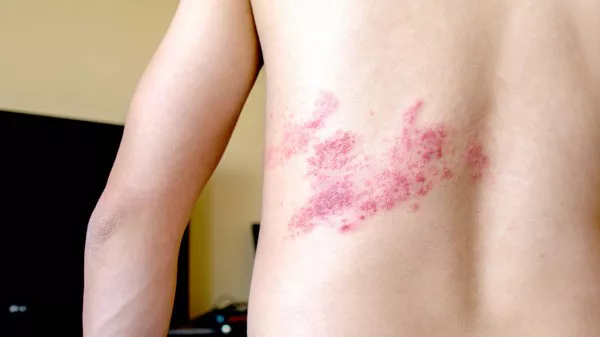Shingles, caused by the varicella-zoster virus, manifests as a painful rash and can lead to complications if not managed properly. While medical treatment is crucial, adopting a balanced diet can complement conventional therapies by boosting your immune system and aiding in the healing process. In this comprehensive guide, we delve into the best dietary practices to alleviate symptoms and promote recovery from shingles.
Understanding Shingles: A Brief Overview
Before delving into dietary recommendations, it’s essential to understand the nature of shingles. Shingles is a viral infection characterized by a painful rash typically appearing on one side of the body. It is caused by the reactivation of the varicella-zoster virus, the same virus that causes chickenpox.
The primary symptom of shingles is a painful rash that develops into fluid-filled blisters. Other symptoms may include fever, headache, fatigue, and sensitivity to light. While the rash usually resolves within a few weeks, some individuals may experience lingering nerve pain known as postherpetic neuralgia.
The Role of Diet in Shingles Recovery
While there is no specific diet that can cure shingles, consuming certain foods can support your body’s immune response and overall health, potentially speeding up the recovery process. A balanced diet rich in nutrients can help alleviate symptoms, reduce inflammation, and bolster your immune system’s ability to fight off the virus.
Key Nutrients for Shingles Recovery
1. Vitamin C: Renowned for its immune-boosting properties, vitamin C plays a crucial role in supporting the body’s defense mechanisms. Foods rich in vitamin C include citrus fruits, strawberries, kiwi, bell peppers, and broccoli. Incorporating these foods into your diet can help reduce the severity and duration of shingles symptoms.
2. Zinc: Zinc is vital for immune function and wound healing, making it an essential nutrient for individuals with shingles. Foods high in zinc include lean meats, seafood, nuts, seeds, and legumes. Incorporating zinc-rich foods into your diet can support the healing of shingles-related skin lesions and promote overall recovery.
3. Vitamin E: As a powerful antioxidant, vitamin E helps protect cells from damage caused by oxidative stress. Including foods rich in vitamin E, such as almonds, sunflower seeds, spinach, and avocado, can aid in reducing inflammation and promoting skin health during shingles recovery.
4. Omega-3 Fatty Acids: Found in fatty fish, flaxseeds, chia seeds, and walnuts, omega-3 fatty acids possess anti-inflammatory properties that can help alleviate pain and inflammation associated with shingles. Adding omega-3-rich foods to your diet may contribute to a smoother recovery process.
5. Lysine: Lysine is an amino acid that may inhibit the replication of the varicella-zoster virus. Foods high in lysine include poultry, fish, dairy products, legumes, and nuts. Increasing your intake of lysine-rich foods may help suppress the activity of the virus and reduce the frequency and severity of shingles outbreaks.
Foods to Avoid
While certain foods can support shingles recovery, others may exacerbate symptoms or interfere with treatment. It’s advisable to limit or avoid the following:
1. Processed Foods: Highly processed foods high in sugar, unhealthy fats, and additives can weaken the immune system and promote inflammation, potentially worsening shingles symptoms.
2. Sugary Snacks and Beverages: Excessive consumption of sugary snacks and beverages can impair immune function and exacerbate inflammation, undermining your body’s ability to combat the virus.
3. Alcohol: Alcohol consumption can suppress the immune system and interfere with medications used to treat shingles. Limiting or avoiding alcohol during shingles recovery is advisable to support optimal healing.
4. Spicy Foods: Spicy foods may irritate the digestive system and exacerbate gastrointestinal symptoms that can accompany shingles. Avoiding overly spicy foods can help prevent discomfort during recovery.
Hydration and Overall Wellness
In addition to focusing on dietary intake, staying hydrated is essential for supporting the body’s healing processes. Adequate hydration helps maintain skin health, supports immune function, and facilitates the elimination of toxins from the body. Aim to drink plenty of water throughout the day, and consider incorporating hydrating foods such as cucumbers, watermelon, and broth-based soups into your diet.
Furthermore, prioritizing overall wellness through stress management, adequate rest, and regular physical activity can complement dietary efforts and promote holistic healing during shingles recovery. Engaging in relaxation techniques such as meditation, yoga, or deep breathing exercises can help alleviate stress and support immune function.
Consultation with a Healthcare Professional
While adopting a healthy diet can support shingles recovery, it’s essential to consult with a healthcare professional for personalized guidance, especially if you have underlying health conditions or are taking medications that may interact with certain foods. A healthcare provider can offer tailored recommendations and ensure that your dietary choices align with your overall treatment plan.
Conclusion
While there is no one-size-fits-all diet for shingles, focusing on nutrient-dense foods that support immune function, reduce inflammation, and promote skin health can aid in the recovery process. By incorporating vitamin C, zinc, vitamin E, omega-3 fatty acids, and lysine-rich foods into your diet while avoiding processed foods, sugary snacks, alcohol, and overly spicy foods, you can provide your body with the essential nutrients it needs to combat the varicella-zoster virus and promote healing. Additionally, staying hydrated and prioritizing overall wellness through stress management and adequate rest can further support your body’s recovery efforts. Always consult with a healthcare professional for personalized guidance and recommendations tailored to your individual needs and circumstances.
Related Topics:
Is Shingles Dangerous for Newborns?
























